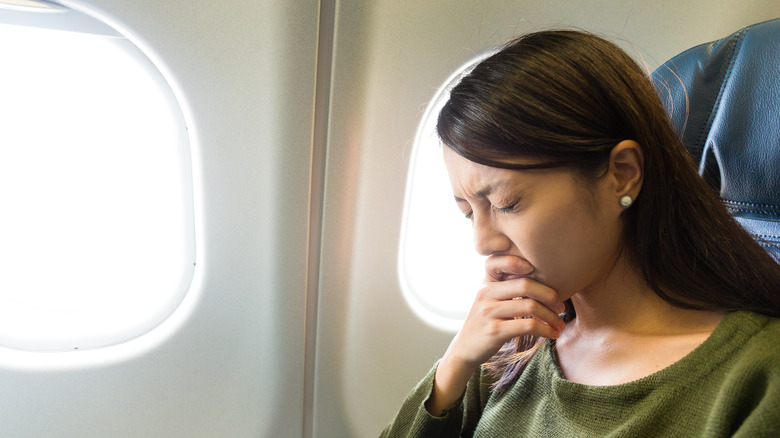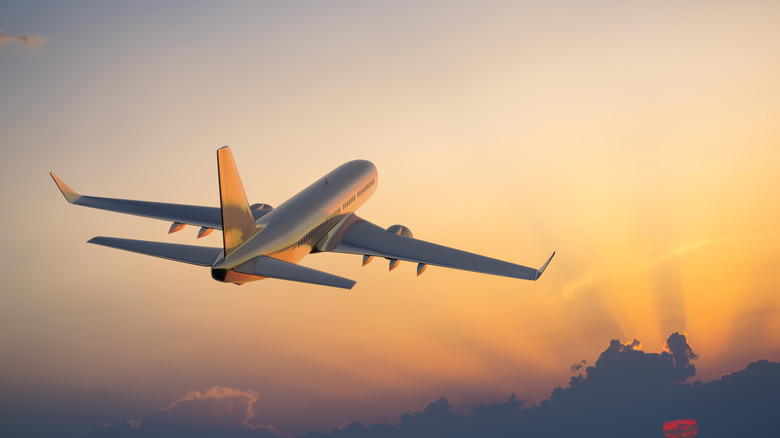The Best Time To Book A Flight For Anxious Fliers Who Hate Turbulence
We've all been there. Your flight takes off and you're about to drink your beverage from the cart when, suddenly — the plane starts shaking or bouncing. The seatbelt light is turned on, and the pilot or flight attendants tell you there is turbulence before stopping in-flight service and taking their seats. It can cause you to feel ill, and for those people who have anxiety about flying in the first place, some rough moments. Injuries from turbulence are rare, but they do happen. Even if you understand why turbulence occurs, it can still be a pretty scary experience. There are some ways to temper your odds of having it happen on your plane. If you book your flight for late night and early morning, you're likely to have less turbulence to disrupt your trip.
Turbulence can happen for a few reasons. If you encounter storms or bad weather on your flight, the plane can move and shake. It can also happen because, when warm air rises and contacts cool air, the resulting airflow patterns can move things around. Large structures on the ground like mountains or tall buildings can disrupt the flight as well. It's what's happening outside the plane, not inside. Here is all the info you need about when to book your flight to avoid turbulence, as well as other tips to help you get through it with as little anxiety as possible.
Booking your flight to avoid the bumps
According to the Federal Aviation Administration, there have been 34 passenger (and 129 crew) injuries caused by turbulence between 2009 and 2022. To put that in perspective, the Bureau of Transportation Statistics says 853 million people flew in 2022 alone. The National Transportation Safety Board reported in 2021 that the injured people were largely not wearing seatbelts.
Early morning or late night flights can help with slower wind speeds, fewer storms, and denser, cooler air that causes less turbulence. Where you sit can also help reduce how much turbulence you feel. The front of the plane is beyond the center of gravity for the aircraft, so you won't feel it as much as people in the back. Over the wings is another great spot as they give the plane stability and balance. And sit in this spot if you're worried about getting motion sickness during your flight.
Another thing that's important is plane size. You may not have much of a choice when you're flying to certain places, but the larger the better. Think about it like cruise ships versus small boats. A sailboat is going to be rocked by waves more than an ocean liner. If you already booked your flight and want to know what to expect, there is a site called Turbulence Forecast which can give you detailed information. Do note that it's not free, but even clicking on the site will show you a map of troublesome areas.
Other things to help cope with turbulence
A morning or late night flight, your choice of seat, and the size of the plane will help you avoid some turbulence, but it is a normal part of flying. It can happen, even with those precautions. If it does, there are a few things you can do to help you get through it. First, always buckle your seatbelt when you're sitting down. Certainly put it on as soon as you see the seatbelt sign light up or hear an announcement from the crew. Make sure your child is in a safety seat if required.
Another thing to check is if your plane's in-flight entertainment system has a meditation section or breathing techniques as many do now. They're worth trying, as are apps on your phone like Calm or the Mindfulness on an Apple Watch. Doing things to distract yourself like watching a comforting show at your seat or your phone/device. Crocheting or knitting can be a good thing to concentrate on as well. It's also worth looking at this amazing app which is a game-changer for nervous fliers in turbulence. You can even let the flight attendant know you're a nervous flier so they can be there to support you if you need help.
Speak to your doctor or mental health professional beforehand about techniques to help you get through the anxiety. Finally, use these tips from travel pro Samantha Brown to secure the best seat possible on a plane.


